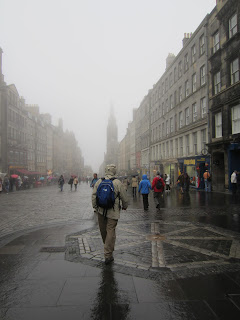Fortified by a not quite-full Scottish breakfast (no beans, tomatoes, or mushrooms), we headed to the Royal Mile, Edinburgh's walk through history. It is also full of shops selling whiskey, shortbread, kilts, and cashmere sweaters, which we did visit. We started at the top of the mile, the Edinburgh Castle which sits high above the city on an extinct volcanic rock. From the moment we stepped inside the gate we were exposed to Scotland's long history, a story of people trying to control their own destiny. In the long run, the Scots have had more success maintaining their culture, if not their government.
Guarding the entrance to the castle are statues of two figures dominant in Scotland's determination for self rule.
Edinburgh Castle
 |
Robert the Bruce
|
 |
| William Wallace |
In the late 1200s William Wallace ("Braveheart") fought King Edward I of England who had assumed power in Scotland. Wallace was eventually killed for his efforts but in time his actions inspired Robert the Bruce to continue the fight against England. England was finally expelled from Scotland in 1314 and Robert the Bruce's descendants ruled Scotland for the next 400 years. England obtained control of Scotland not in battle but when King James VI of Scotland became King James I of England due to the fact that Elizabeth I had left no direct heirs and James, son of Mary Queen of Scots whom Elizabeth had put to death, was the next eligible heir.
We went on a walking tour that highlighted various parts of the castle. As we walked up to the Crown Square, the most important part of the castle, the views of the city below were impressive even on a cloudy day.
Looking at Princes St. (with all the red and white construction barricades). The cannon is the "One o'clock" gun. It is fired at precisely 1:00 to set the time daily.
Waverly Station (the train station) to the right.
On the Crown Square are a number of noteworthy buildings: the Crown jewels (No pictures allowed. One not so glamorous looking but very important item is the Stone of Destiny. This gray rock is literally the seat of power--Scottish kings of old were crowned sitting on it. It was taken by the British in 1296 and put underneath the the coronation chair in Westminster Abbey until Queen Elizabeth returned it to Scotland in 1996. It will be used in Westminster for future coronations but then returned to Scotland again.), the Royal Palace where Mary Queen of Scots gave birth to James VI (James I of England), the Scottish National War Memorial, St. Margaret's Chapel (the oldest building in Edinburgh, Romanesque style), and the Great Hall.
 |
| Interior, St. Margaret's Chapel |
 |
| War Memorial |
 |
Great Hall
After hours of wandering over the Castle on increasingly tired legs, we decided it was finally time to leave and explore other areas of the Royal Mile. We didn't have a plan other than to find the Writer's Museum which we eventually did. This small museum, down a small street just off the Royal Mile, celebrates the Scottish authors Sir Walter Scott, Robert Burns, and Robert Lewis Stevenson. Another museum we happened upon was the National Museum of Scotland. It's a very modern looking building containing exhibits of all kinds. We were there for less than an hour but could have spent the whole day there as well.
A sign seen upon entering the Kingdom of Scots exhibit. Things haven't turned out as out quite this way.
The Millennium Clock. Weird--lots of skulls and grotesque figures. It is supposed to represent the suffering of mankind during the 20th century.
A cast of the grave of Mary Queen of Scots. Her image and story are everywhere.
As we were walking through the Great Hall, a huge Victorian space with large exhibits of machinery engineered by clever Scots and a Victorian garden gazebo, we saw a bride and groom having their picture taken in the gazebo. I will say that Scottish grooms are every bit as interesting to look at as the brides. Men are dressed in their colorful kilts and sport a purple thistle boutonniere--makes a black tuxedo seem downright boring.
We weren't making much progress towards Holyrood Palace at the end of the Royal Mile--too many places to look at. We stopped in at the St. Giles Cathedral if only to rest our feet for a bit.
Luckily for us, there was a music recital going on. This was a mixed choir singing not particularly religious songs but very joyful ones. I don't remember anything more about the Cathedral other than it was a blessed rest.
The cloudy day was turning misty and rainy so we headed south for a pub dinner and and end to this day's exploration of the Royal Mile. |













No comments:
Post a Comment